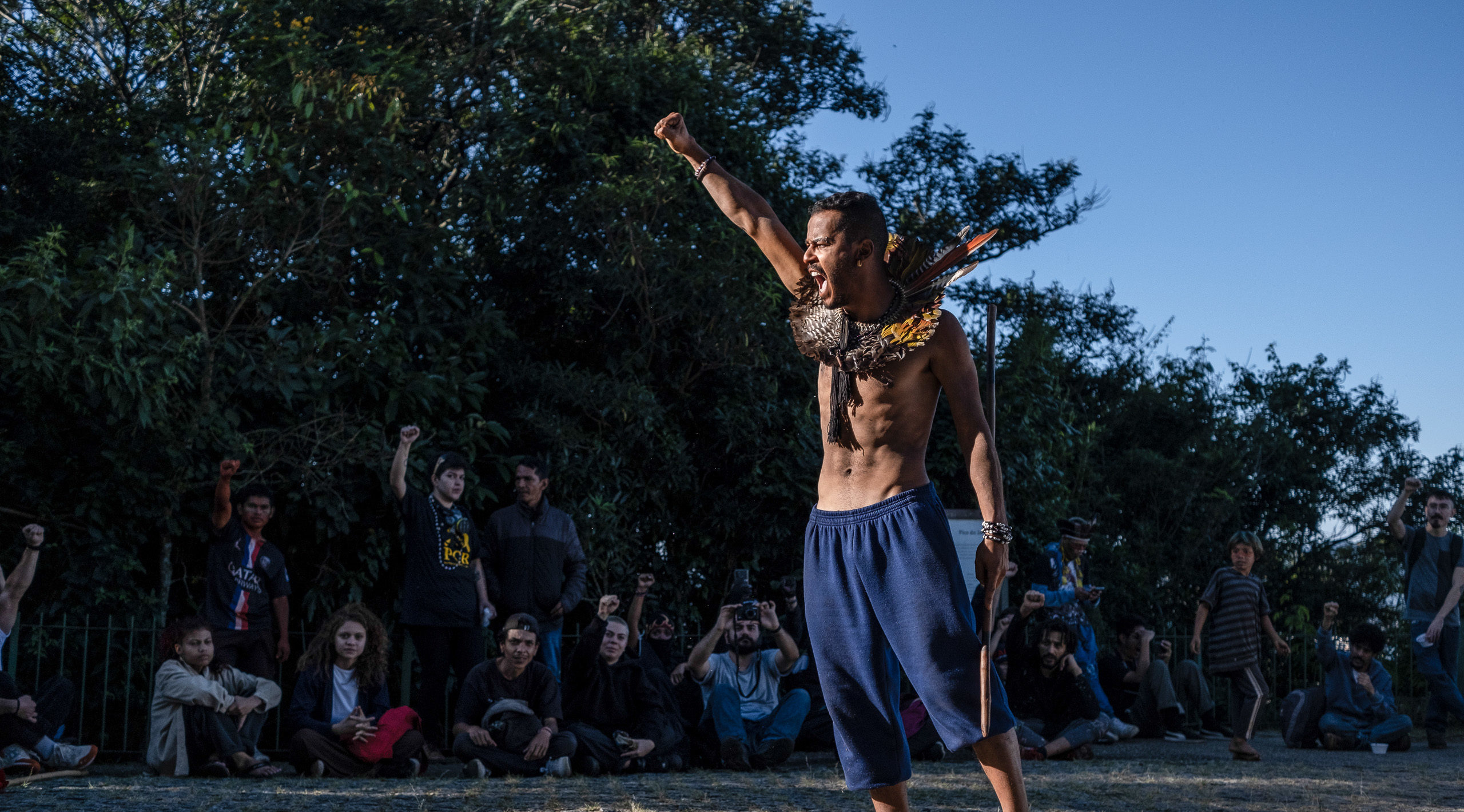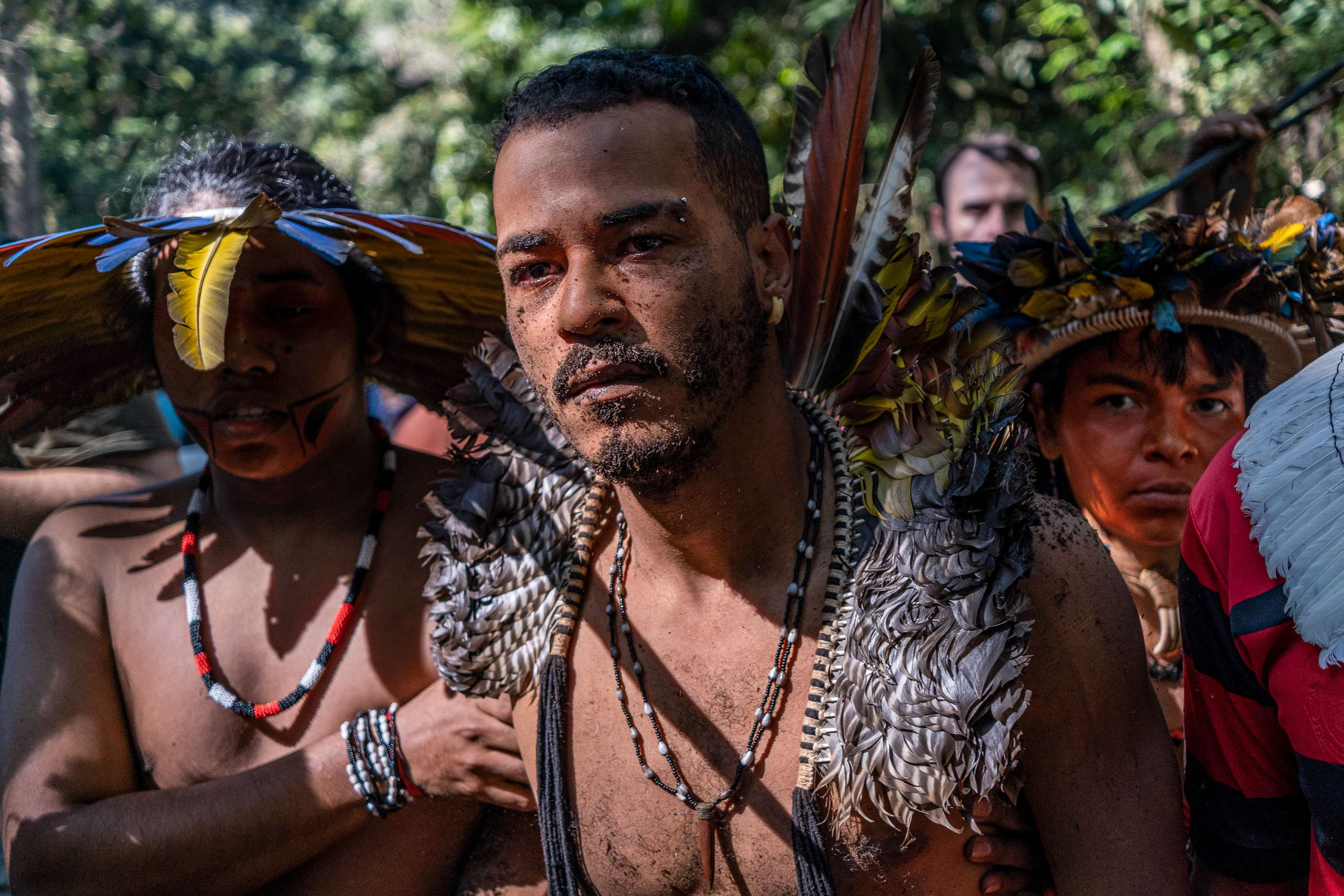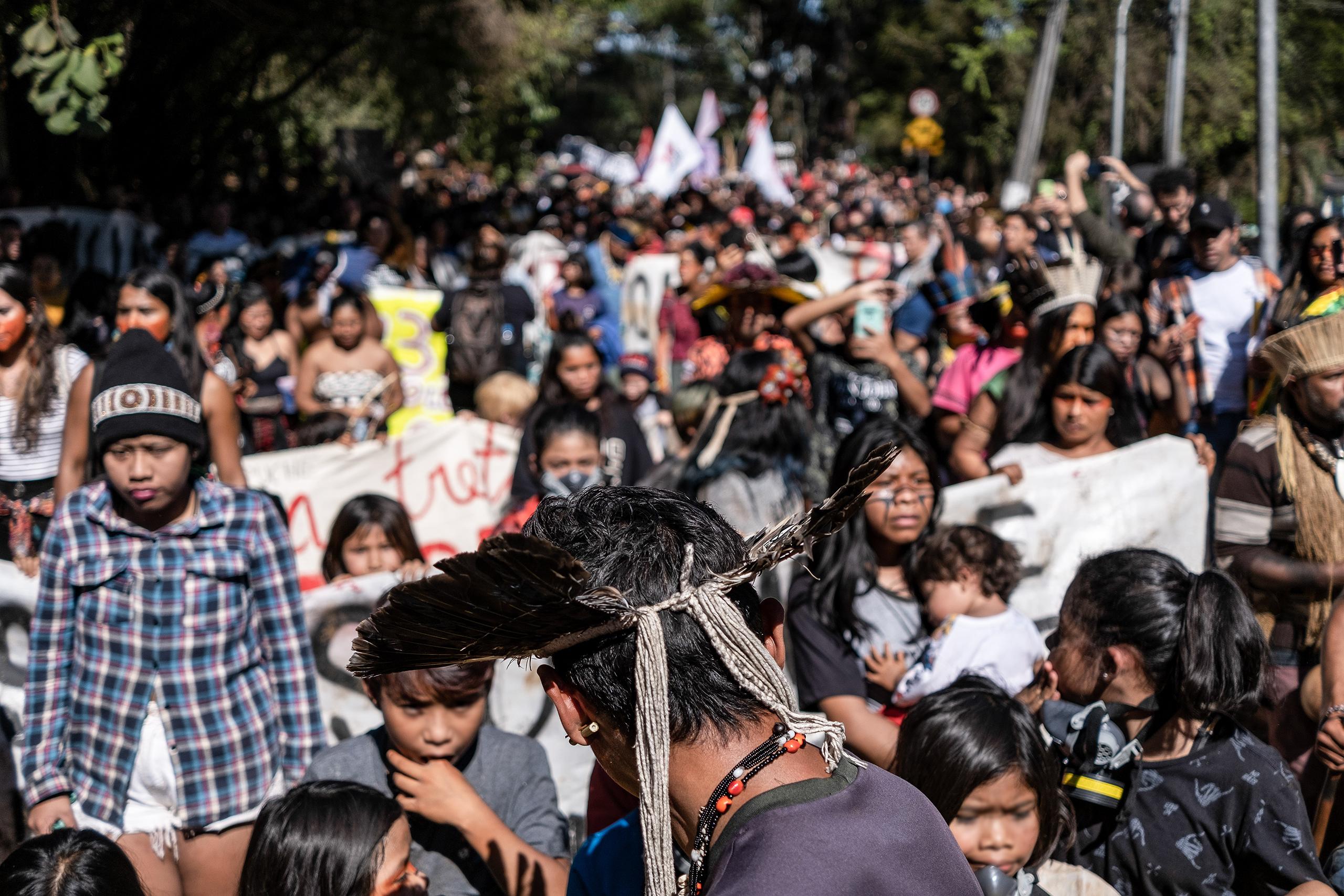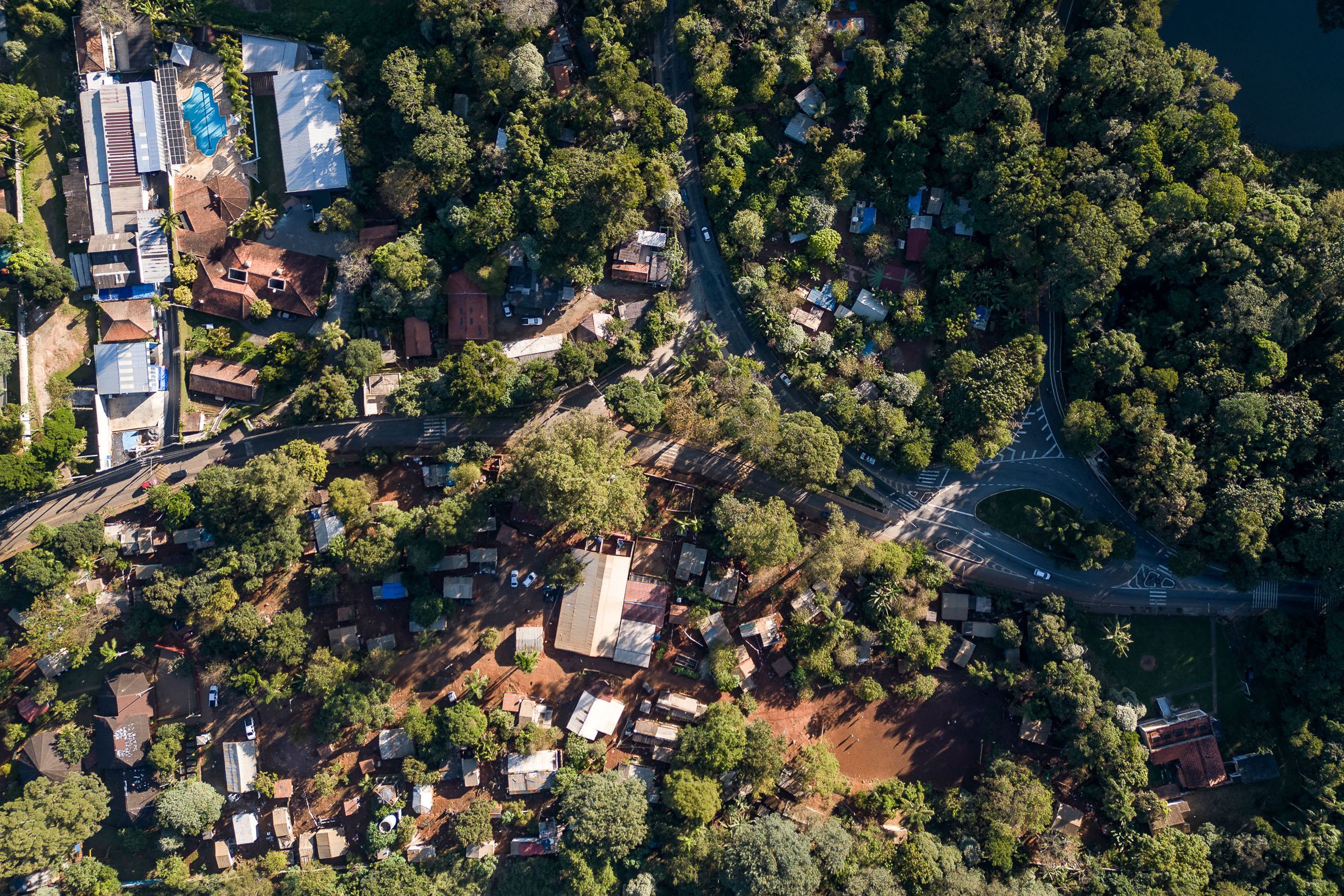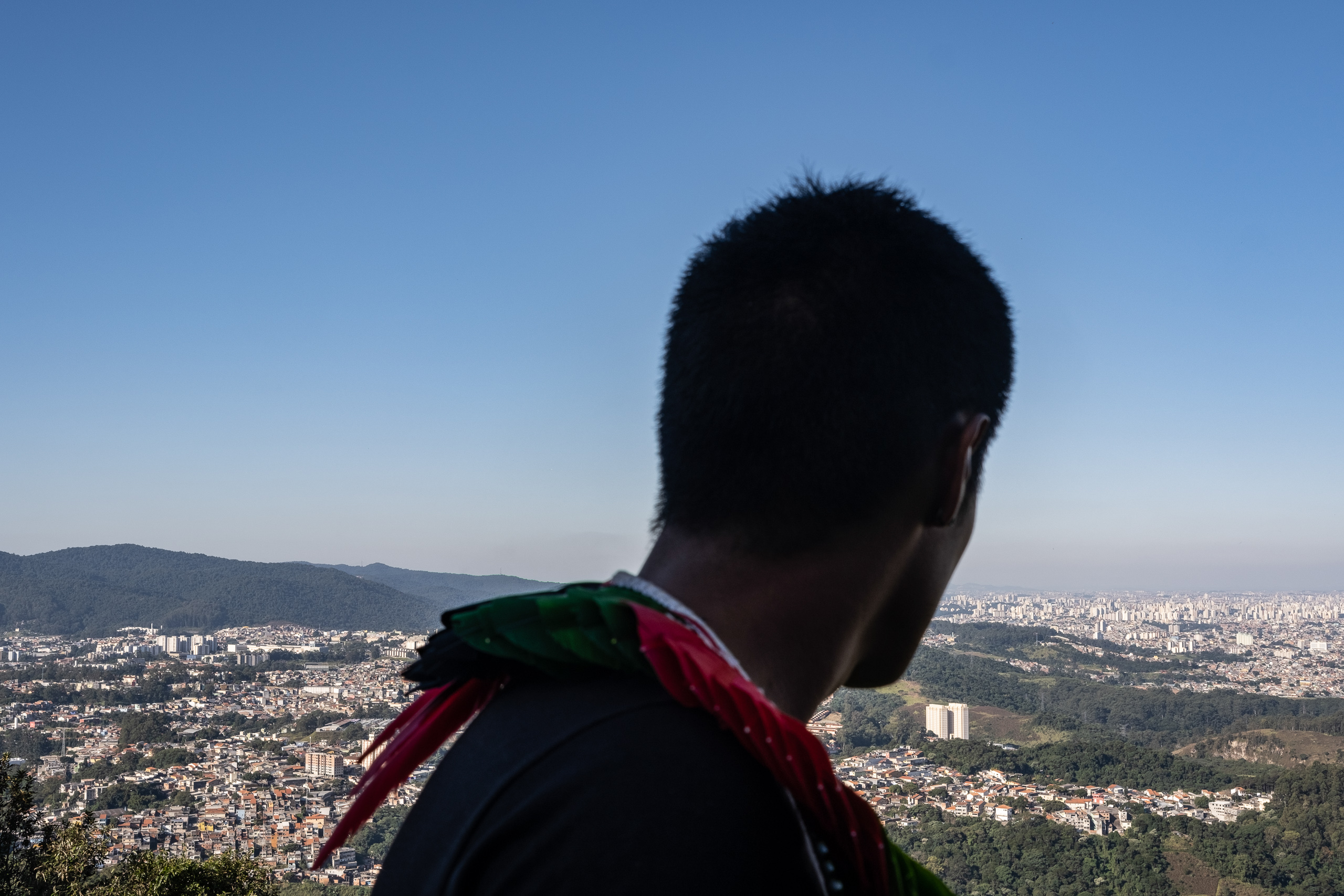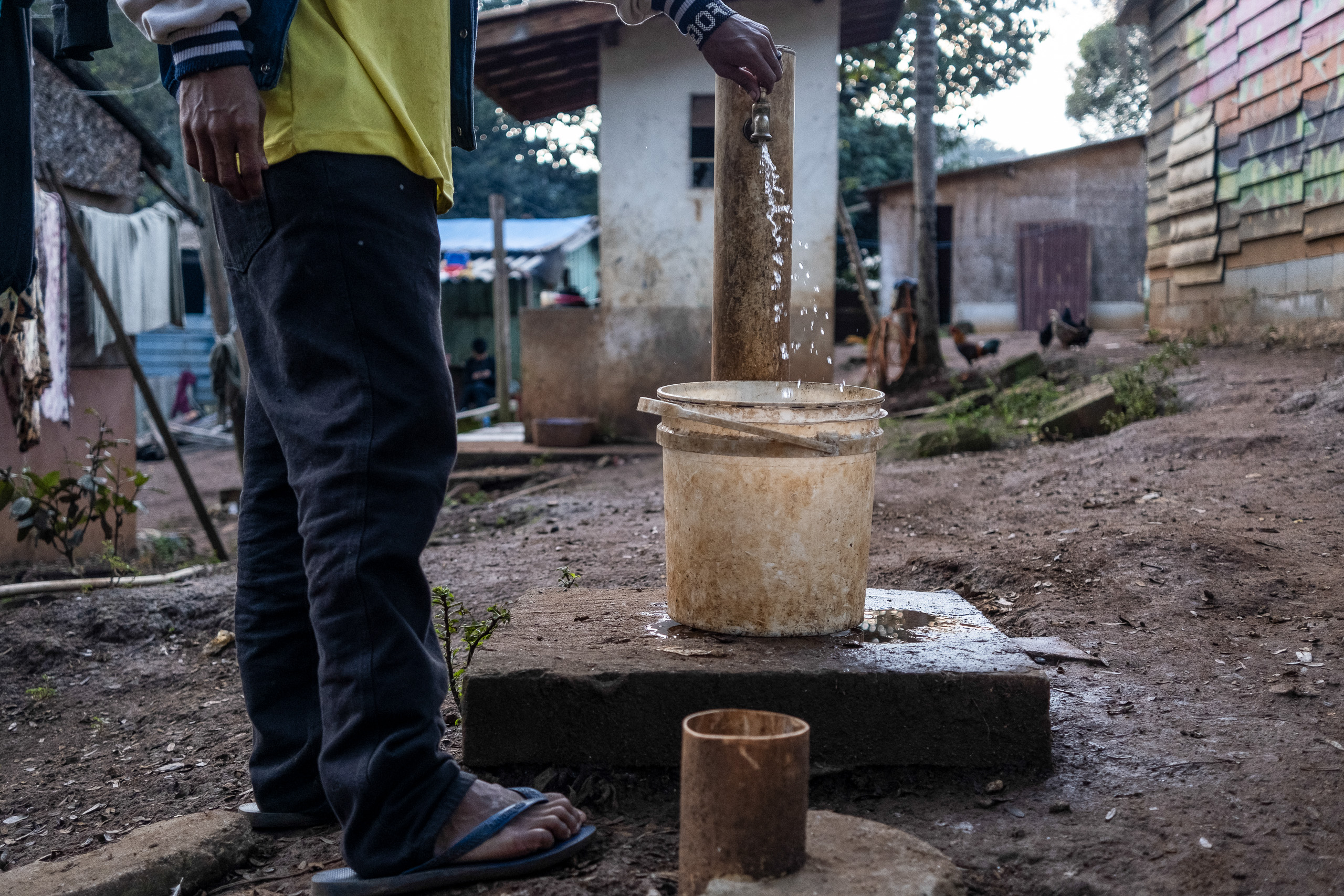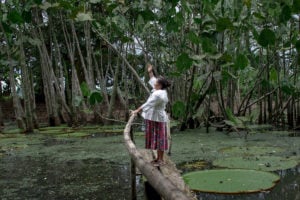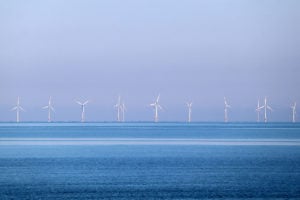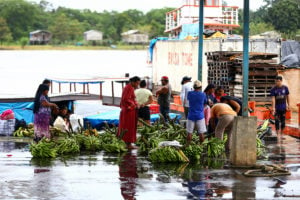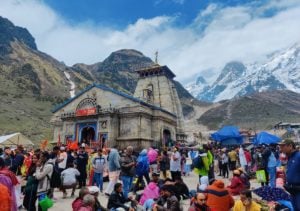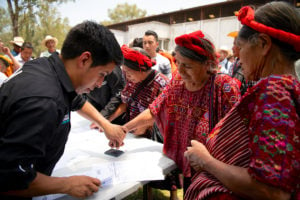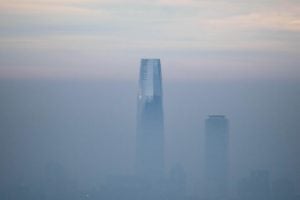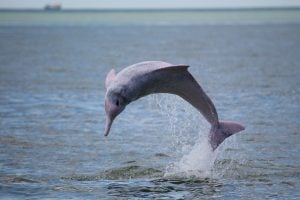The sight of military police encircling the prayer house was a sign of the tensions facing the Guarani Indigenous people. On a cloudy day in early June, dozens of Guarani came together to pray, sing and dance, in protest against threats to their territory of Jaraguá, just 20 kilometres north-west of São Paulo’s urban centre.
The ritual began in the late afternoon, in the village of Tekoá Pyau. Among the congregation was Txai Suruí, a 26-year-old Indigenous activist, who became internationally known for her powerful speech at the COP26 climate conference in Glasgow in 2021. Originally from a Paiter Suruí Indigenous territory in the state of Rondônia, some 2,000 kilometres north-west, in the Amazon, Suruí was here to protest alongside her partner, Thiago Karai Djekupe, one of the Guarani leaders in Jaraguá.
The group gathered to protest actions – both in Brazil’s congress and its supreme court – that could prevent Indigenous people from legally claiming their ancestral territories. On 30 May, the Chamber of Deputies, the lower house of congress, approved a bill on the marco temporal, or “time limit” – a proposal that would only recognise Indigenous communities’ claims to territories if they were occupying the lands in 1988, the year of Brazil’s current constitution. The bill is now up for a vote in the senate.
A week later, on 7 June, the supreme court resumed its deliberation over the controversial proposal, which has been moving through the country’s court system since 2007. The top court was expected to issue a ruling, but Justice Andre Mendonça, appointed by former president Jair Bolsonaro, requested to suspend the case. It is expected to resume by September.
According to Suruí, if approved, these legal changes would represent “the death not only of Indigenous peoples, but of the planet, in the face of humanity’s greatest challenge, climate change.”
In the run-up to the vote, a wave of protests took place across Brazil, called by the Articulation of Indigenous Peoples (APIB), a network bringing together Indigenous organisations from across the country. On the day congress approved the bill, more than 100 protesters, including people from 21 different ethnic groups, occupied the Bandeirantes, one of the main highways in São Paulo.
Police forcibly removed them from the highway, in addition to carrying out low helicopter fly-bys in order “to surround them and follow them to the villages,” Djekupe claims. “They didn’t need to do that; we are not a people of violence.
“We are the Guarani nation, which has lived here since long before any coloniser ever thought of setting foot on this land.”
We are the Guarani nation, which has lived here since long before any coloniser ever thought of setting foot on this landThiago Karai Djekupe, Guarani leader
On 3 June, after a ruling from the São Paulo court of justice prohibited them from returning to the highway, the group turned instead to their religious ceremony in the village, which was held as their next act of protest.
Resistance against land threats
Though they are both young, the activist couple’s lives have long been shaped by various conflicts. Suruí is the daughter of activists Ivaneide Bandeira Cardozo and Almir Suruí, who for decades have fought for the preservation of Indigenous lands in the Amazon. Djekupe, aged 29 and born and raised in Jaraguá, is the grandson of Jandira Augusta Venício, a woman who led the village and sought better conditions for its people.
It was through his grandmother’s influence that Djekupe learned to resist the threats facing their territory, which has been increasingly hemmed in by urban development. Today, around 600 Guarani people occupy this 1.7 hectare area – the smallest recognised Indigenous territory in Brazil – but they claim ancestral lands that extend over 500 hectares within the wider district of Jaraguá. These lands overlap with a state park that is home to Pico do Jaraguá, the highest point in São Paulo at 1,135 metres. Seen from its summit, the horizon of this Latin American metropolis has been taken over by imposing buildings, standing in stark contrast to the lush stretch of Atlantic Forest that covers the mountain.
Though already surrounded by wide highways and luxury apartment blocks, Jaraguá faces continued pressure from real estate developers.
“We know that for the jurua [the Guarani term for white Brazilians], the land where we live has a high value per square metre,” says Djekupe. “But our lives do not.”
In May, São Paulo councillors began discussing changes to regulations in the city’s upcoming masterplan. One of their main proposals is to expand the zone in which buildings have no height limit to include the surroundings of Jaraguá. “There have been many moves to make irregular subdivisions [of lands to enable new developments], promoted by powerful people,” councillor Luana Alves told Diálogo Chino.
Pollution and threats intensify
While glossy luxury apartments continue to rise near the foot of the Pico de Jaraguá, conditions within the Indigenous territory have become increasingly cramped and weathered. In Tekoá Pyau village, families of the Tupi-Guarani and Guarani-Mbya Indigenous peoples share housing, bathrooms and kitchens. Some houses, built with support from social organisations, are made of sturdy wood, while others that are self-built are more precarious, constructed from scrap and plywood.
The village’s school and community centre are made of brick, while the traditional Guarani style of building, using clay and wood, can still be seen at the prayer house. The local football pitch is busy, with a women’s team using it.
In the late afternoon, residents gather around small fires to warm themselves in the winter cold of São Paulo, which experiences an average daily low of 13C in July. Everyone has electricity, but access to water is more limited and often runs out at night. Sewage in the village is not treated.
Djekupe says he misses the days he used to spend bathing in what the local community affectionately refers to as “Grandma’s river” – the Ribeirão das Lavras, which cuts through the territory. “Before going there, we would go to my grandma’s house,” he recalls. “She taught us to ask permission from the water spirits in order to bathe and get food.”
Previously used by many villagers, the river has now been rendered unusable, having been polluted by sewage.
According to Djekupe, both the pollution and threats to the village have intensified amid drawn-out debate over the marco temporal bill and supreme court action. “This lack of clarity encourages invaders [into their claimed area], who believe their actions will be legalised in the future,” says Djekupe.
In May, Txai Suruí was ambushed by a group of around 50 men in the Uru-Eu-Wau-Wau Indigenous territory, her home in Rondônia state.
Lawsuits defend marco temporal
The marco temporal bill is currently being considered by senate committees, but a date for the upper house vote has still not been set. The supreme court case, meanwhile, is expected to resume by September. This case stems from a territorial dispute between the state government and the Xokleng people of Santa Catarina state, in southern Brazil – but if approved by the court, it could impact all land demarcations across the country.
“Upon receiving this case [as rapporteur], supreme court minister Edson Fachin declared that the decision will have ‘general repercussion’ – that is, it will apply to all cases in Brazil that deal with the same topic,” says Ana Carolina Alfinito, a lawyer and researcher with APIB.
Those defending the state’s case, such as the bill’s rapporteur and federal deputy Arthur Maia, as well as representatives of agribusiness, argue that it would guarantee legal certainty for landowners.
Both the bill and the supreme court case involve the marco temporal, which would require Indigenous peoples to prove that they occupied the areas they claim on 5 October 1988, the day Brazil’s federal constitution was enacted, following the end of the country’s military dictatorship (1964–1985).
The marco temporal proposal would disregard the forced displacements that Indigenous peoples have suffered throughout history, particularly at the beginning of European colonisation starting from the 16th century, as well as during the military dictatorship. It also overlooks the existence of archaeological evidence of the occupation of Indigenous peoples in Brazilian territory – such as that of the Guarani peoples in the modern-day states of São Paulo and Mato Grosso do Sul “at least two thousand years ago,” explains Eduardo Neves, professor and director of the Museum of Archaeology and Ethnology at the University of São Paulo.
Although the marco temporal proposal appears in both lawsuits, the bill, according to Alfinito, has “many more devastating and clearly unconstitutional points.” The law would allow, for example, economic activities, such as mining, that would degrade the vegetation protected by Indigenous lands.
For Djekupe and Suruí, environmental protection must be prioritised above economic interests – something Indigenous groups can play a key role in supporting. “We preserve the trees, the endangered bees and hundreds of springs in [Jaraguá], where there is a very important water table [the underground level below which water can be found],” says Djekupe.
For Suruí, ensuring the protection of these Indigenous lands – and the ecosystems within them – will have implications far beyond their ever-threatened borders: “We’re not just talking about the lives of the Indigenous peoples. We’re talking about the lives of everyone, including those who are deciding against our future.”
